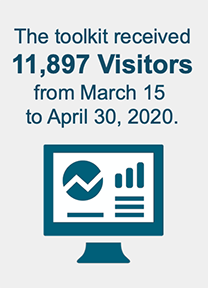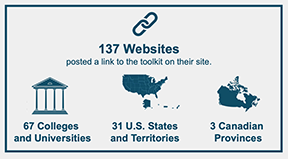When Access Goes Viral, Tracking UA Partners' Toolkit for Creating an Accessible Online Course
June 8, 2020

|
| Text reads: The toolkit received 11,897 visitors from March 15 to April 30, 2020. |
University of Arkansas - Partners for Inclusive Communities (Partners), Arkansas' UCEDD, has a variety of projects that focus on accessible design. Project staff have created a website called Explore Access: Tools for Promoting Disability Access and Inclusion (exploreaccess.org) which offers several resources and toolkits. Among the target audiences for these resources are those working in higher education settings.
In mid-March 2020, as campuses across the country prepared to move all classes online as a result of the COVID-19 pandemic, Melanie Thornton, Partners' Coordinator of Access and Equity Outreach responded by developing a toolkit called Designing an Accessible Online Course. She announced the resource on 5 professional discussion lists and on Partners' social media platforms. What resulted was surprising.
The toolkit received 11,897 visits between March 15th and April 30th, 2020. The link to the toolkit was shared by 137 organizations on their websites. 67 of these organizations were colleges and universities located in 31 states and 3 Canadian provinces. For comparison sake, the next most popular toolkit had about 1000 visitors during this same period, about 1200 hits in the first 45 days it was released, and currently has 18 links from external sites.
Clearly, the resource went viral as a result of the pandemic and the need for instructors to move their courses to an online environment quickly. This in turn resulted in other pages on the University of Arkansas Partners' Explore Access website receiving more visits and the associated newsletter increasing its subscribers by twenty-five percent.
The toolkit has been received very positively by faculty and disability resource professionals. Among the many comments received, from disability resource professionals were, "Thank you so much for this. I was able to share this with my faculty and it looks great. I am so impressed that you were able to put this together so quickly!" and, "This is such a great tool! As people are working from home, departments are engaging with students in a variety of ways online. I think this is the perfect opportunity to remind them about making their messages accessible to all. I am so appreciative that tools like this exist, so we don't have to reinvent the wheel!" A comment from an instructor who used the toolkit was, "This is a good overview of accessibility challenges and how to better address them. Many of these things I had not thought about and/or did not know tools existed. As a result of using this toolkit I plan to make changes to my documents and slides."
Melanie Thornton reflected, "This toolkit was on our list of possible projects and when I realized what a daunting challenge was ahead for both disability resource providers and faculty to move courses online and the barriers that could result for students, it seemed the perfect time to move this up to the top of our list. The viral sharing of it has really caused me to think about how, when and where we share our products and how to better capture, not just the numbers, but the impact our products are having."
Some of the strategies that project staff have identified to capture additional information about toolkit usage are to add a brief survey to all of their toolkits-asking how helpful the toolkit was and what changes the user plans to make as a result of using the toolkit. They are also adding a plug-in to measure time spent on a page in order to understand more about the level of engagement with the content.
Melanie added, "Most importantly, I hope the availability of this resource has resulted in fewer barriers for at least some of the students with disabilities who have had to move so rapidly to an online environment."
Link: https://exploreaccess.org/accessible-online-course/

Text reads: 137 websites posted a link to the toolkit on their site. 67 colleges and universities, 21 U.S. States and territories. 3 Canadian provinces.







